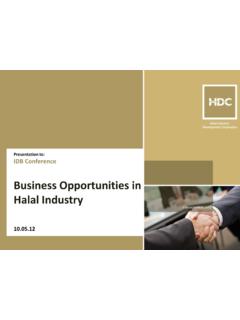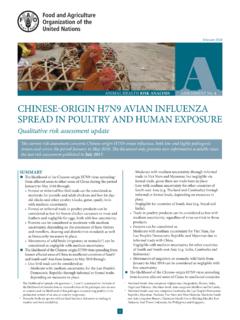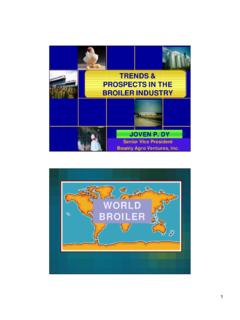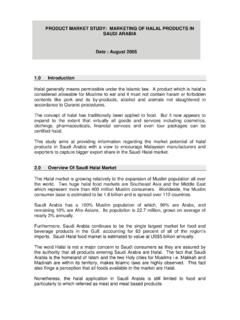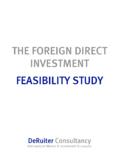Transcription of Minimally Processed Foods - Thailand Board Of Investment ...
1 Thailand sFood IndustryFood Industry in Thailand Kitchen of the World An abundance of natural resources combined with significant investments in technology, food safety R&D and adhering to international quality standards have helped to dub Thailand as the Kitchen of the World. As the largest sole net food exporter in Asia, Thailand is one of the world s largest producers of food products such as rice, canned tuna, frozen seafood, chicken and canned 2011, the value of Thai food exports increased 20% from the previous year owing to strengthened economic performance amongst major food importers such as the US, Japan, and ASEAN ItemsMetrTonTotal Food29,035,Fisheries1,672 Shrimp358 Tuna506 Other canned fish193 Frozen fish408 Cuttlefish81 Others124 Cereal10,376 Rice10,218 Others158 Meat858 Chicken (Prepared/Preserved)400 Others458 Fruit2,016 Pineapple (Canned/Preserved)650 Pineapple Juice 152 Mango 36 Others1,176 Vegetable491 Sweet Corn (Canned) 172 Baby corn (Fresh/Canned)
2 48 Others270 Others Food13,619 Sugar5,011 Non-Alcoholic Beverage425 Seasoning177 Palm oil498 Tapioca (Flour/starch)1,286 Tapioca (Pellet/chip)2,851 Feed695 Pet food268 Others2,405 Thailand s Exported Food Products, 2008 20112008200920102011 MetricTonMillion US$MetricTonMillion US$MetricTonMillion US$MetricTonMillion US$29,035,48125,93528,767,70325,14028,36 8,98526,75533,247,74332,1501,672,7377,13 91,652,2057,0041,729,5497,3211,734,8298, 168358,9282,807398,8943,114427,5813,3653 92,6163,676506,0972,152534,8781,915588,7 271,981594,7512,357193,761555182,7705601 90,681560205,036644408,117781343,8336703 25,476643303,85365181,77844978,40040073, 63841367,269447124,056396113,430344123,4 47359171,30339310,376,4146,8308,677,8835 ,7578,983,0995,62511,121,2246,71710,218, 2866,7758,638,8425,7418,939,6305,60610,7 06,2296,537158,1285439,0421643,46919414, 995180858,5842,119782,0672,016636,0672,0 73545,1942,371served)
3 400,0571,922388,9311,798427,6101,853441, 3432,061458,527198393,136217208,45721910 3,8513102,016,3522,0142,148,6552,0442,05 5,8852,1172,163,1492,296served)650,78368 3539,297554550,018552641,185669152,79318 3151,396217139,877220146,77122736,333484 5,3435342,9875059,691561,176,4431,1001,4 12,6191,2181,323,0031,2951,315,5011,3434 91,487550451,410548465,634544559,5436541 72,872173170,179182182,821182184,178190e d) 48,6155244,5234945,5874946,09251270,0003 25236,708316237,227313329,27441313,619,9 087,28315,055,4827,77314,498,7519,07518, 858,63220,1125,011,8021,5885,052,5702,05 34,500,9692,3116,520,4803,648e425,723240 355,476307400,444409551,900541177,128328 195,097388222,151432237,502482498,115551 185,823157222,000218482,5995321,286,5135 111,817,7355661,764,1078361,918,3749632, 851,4335244,357,0286824,273,2258663,731, 027985695,028289796,044274988,775417878, 463409268,687651242,483609275,040658305, 0387152,405,4782,6012,053,2272,7381,852, 0402,9274,233,24911,837 Source: National Food InstituteFishery productsIn 2011, Thailand exported million tons of fishery products valued at US$ billion, a 12% increase from 2010.
4 This growth is driven by rising demand in the and 2011, the value of rice exports grew by 17% from 2010, owing to higher prices in the wake of natural disasters affecting global food supplies. Livestock ProductsIn 2011, the value of meat exports increased by 14% from 2010. Following the 2011 tsunami and nuclear plant leaks, Japanese consumers significantly contributed to demand increases in poultry and meat products from unaffected countries such as and Vegetable ProductsIn 2011, the value of fruit and vegetable exports grew by 8% and 20% year-on-year respectively. Growth was focused in the Processed fruits and vegetables industries and driven by demand growth from the US and sauce1%Soya sauce4%Oyster sauce5%Fish sauce8%Chili sauce10%Instant curry9%Other sauces16%Other47% Thailand Exports of Food Ingredients, 2011 Source: The Customs Department of ThailandSugarIn 2011, Thailand exported million tons of sugar, an increase of 58% year-on-year, reflecting rising global demand and falling supply from India, due to severe drought in the and IngredientsThailand s strengths in food processing have also brought the country to global prominence in the seasonings and ingredients industries.
5 The abundant supply of raw materials for seasoning and ingredients production and the potential for local skills development to manufacture specialty food products such as seasonings make the country an appealing destination for Investment . The value of Thailand s food ingredients exports in 2011 reached US$479 million. Exports of chili sauce totaled US$47 million, followed by instant curry (US$45 million), fish sauce (US$41 million), oyster sauce (US$22 million), soya sauce (US$18 million) and tomato sauces (US$6 million). Additionally, chili sauce and oyster sauce saw annual growth rates in 2011 of 24%, followed by soya sauce (20%). Thailand s food exports are evenly distributed across major geographic regions globally. In 2011, Japan was Thailand s biggest market for food products, taking 15% of the total the export value, followed by the US at 13%, China at 7%, and Indonesia at 5%.
6 Thailand is a strategic hub of food production for both Asia and the rest of the world due to its biodiversity and natural agricultural productivity. Entrepreneurs in Thailand s agriculture and food processing industries continue to strive to introduce new technologies. In addition, the Thai Government has introduced policies which support food production at high standards of safety and quality. Thailand has both the high potential and the key fundamentals to become a major production base and distribution center for world food production, as well as an attractive destination for international investors. -Dr. Petch Chinabutr, President of National Food Institute (NFI)- Thailand s Top 10 Food Export Markets, 2011 Source: National Food g d When Fresh Produce Meets Technology Thailand s abundant natural resources play a central role in its comparative advantage among its competitors in the food processing industry; 80% of the raw materials in domestic food manufacturing are locally available.
7 The use of these rich natural resources, optimized by the introduction of technology and robust implementation of international standards of food safety and hygiene, will help Thailand remain a world leader in the food processing Government and industry initiatives have helped Thailand s Processed food industry upgrade its procedures and technologies so that its products meet international quality and sanitation standards, thus making them more competitive in the global marketplace. These initiatives have been so successful that Processed food exports now exceed primary agricultural exports. Thai food processors are successfully developing new frozen food products to keep up with shifting tastes in their overseas markets. In 2011, Thailand exported 416,922 tons of ready-to-eat (RTE) food and food ingredients valued at US$955 million a 16% increase over the previous year.
8 Thai RTE food is gaining popularity overseas as other countries grow accustomed to Thai quality, nutrition, and taste. Additionally, sauces and curries are enjoying remarkable success in overseas markets. Between 2010 and 2011, annual growth reached 18% with a total value of US$479 million. Major export markets currently include Japan, the US, Philippines and most Processed food products are for the international market, the domestic consumption of Processed food continues to grow due to changes in lifestyles that have brought about increased demand for convenient food options. These Processed food products are available in a wide variety of venues, most notably major Thai supermarkets such as Tesco, Makro, The Mall Group, Big C, Foodland, and present, the Thai food processing industry is comprised of over 10,000 food-processing companies.
9 Major Thai and multinational industry leaders include: Nestle, Saha Pathana Inter Holding, Patum Rice Mill & Granary, Royal Friesland Foods NV, Unilever Group, Thai Union, Dole Thailand , Charoen Pokphand Group, Betagro, Saha Farms, Thai Beverage, Kellogg s, Kraft, PepsiCo, Del Monte, Procter & Gamble, Ajinomoto and Effem Foods . Dole Food Company has operated a growing Processed fruit business in Thailand for over 35 years. We currently operate three manufacturing facilities and employee more than 8,000 associates. Dole has invested several million dollars over the past few years to upgrade and expand our production facilities in Thailand . The policies of the Thai government and the incentives offered by the BOI have been beneficial to us as investors and have helped to ensure that we earn a reasonable rate of return on our investments in the Kingdom.
10 -Mark Mc Kinney, President of Dole- y s l Halal: Fast Growing Sector Halal food is produced in accordance with Islamic dietary guidelines. According to these guidelines, Muslims cannot consume pork or pork products, as well as any other meat that is not properly slaughtered, birds of prey, carnivorous animals, blood products and alcohol. In Thailand , the Central Islamic Committee sets high standards for the accreditation of halal food companies. Thai halal products are Processed in accordance with the committee s Standard 2001 ( 2544) regulations, which cover production facilities, raw materials, products, storage, employees, transport and distribution. Demand for halal food has increased tremendously during the last few years. The global halal food market is now worth an estimated US$667 billion annually.


